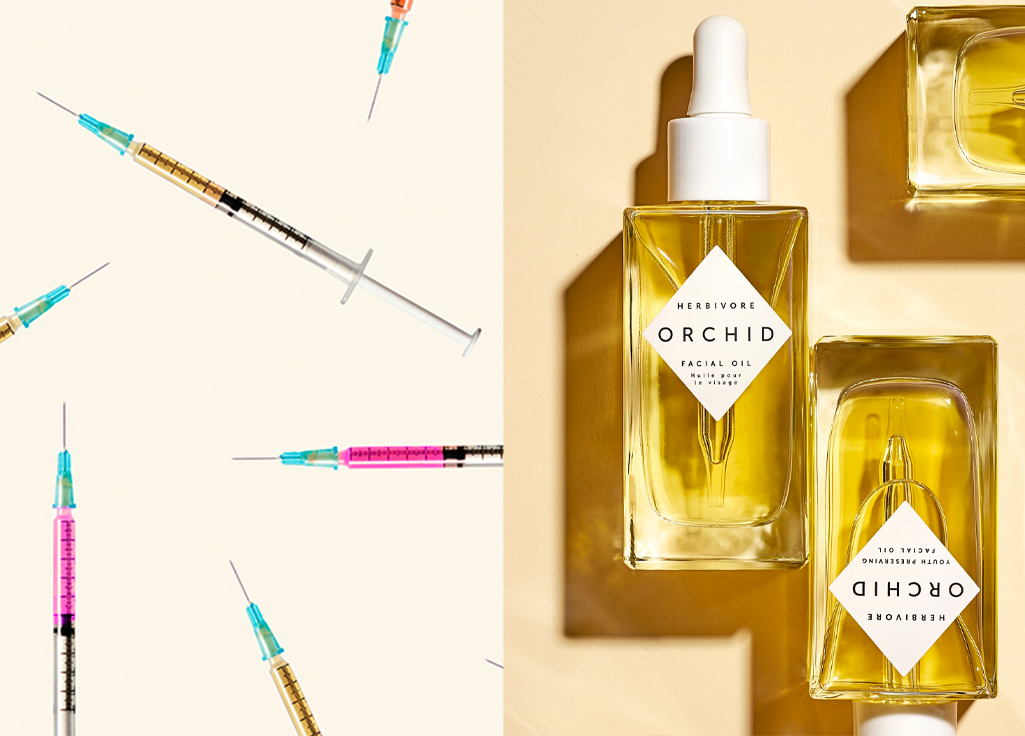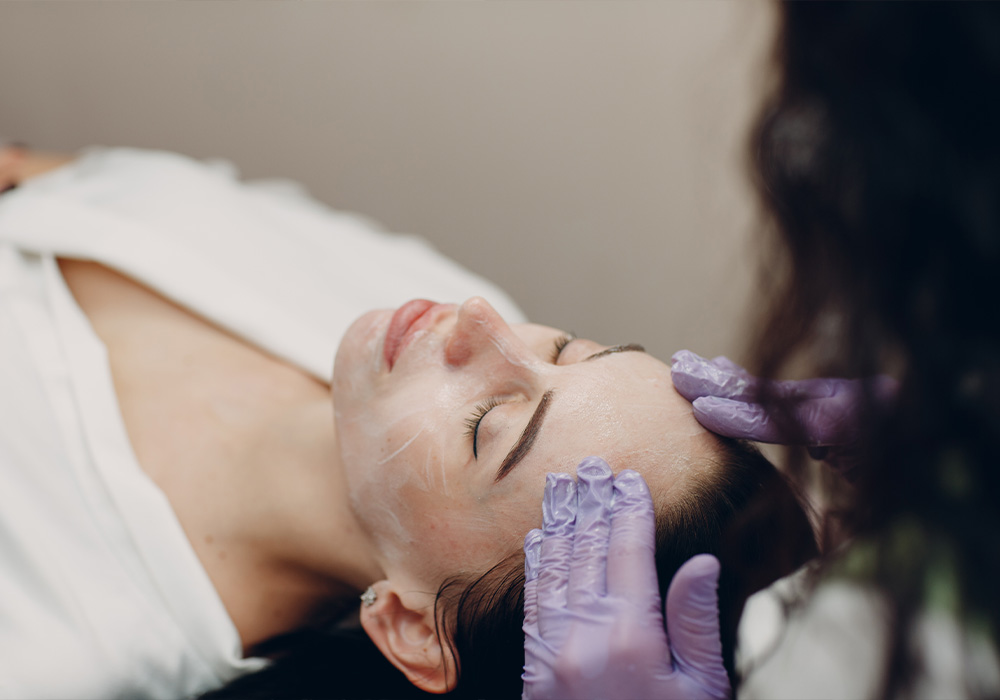Every smile has its own unique set of issues and some need more TLC than just the recommended twice-yearly cleaning and at-home teeth whitening. From a major overhaul to restoring a handful of stained, worn or chipped teeth, veneers and dental bonding can provide a quick fix for common smile concerns. So, which option is best? The cosmetic dentists we spoke to say the one that gives the wearer the most natural look. “Right now, the pendulum is swinging away from the ‘bigger, whiter’ style of the late ‘90s and early aughts,” says Los Angeles cosmetic dentist Jon Marashi, DDS. “I’ve done a lot of revision work on actors who previously had that ‘Chiclet’ or ‘horse teeth’ look.” Today, anyone can get an A-list smile; here’s how these trending treatments stack up.
You May Also Like: Invisalign vs. Traditional Braces: Why Some People Still Choose the Metal Look
PORCELAIN POWER
It’s no wonder veneers are credited for providing a “Hollywood Smile.” The first set was conceptualized in 1928 by California dentist Charles Pincus when he was called on by the Factor brothers (of Max Factor) and prominent makeup artists the Westmore brothers to create a way of fixing faulty smiles for the cameras. When officially introduced as a viable treatment in 1983, veneers offered patients a way to totally make over a smile and quickly ascended to game-changer status in the dentistry world. Fast-forward, and modern-day veneers can address the shape, size and color of a tooth with little-to-no damage to the original tooth structure. “A decade ago, they were much thicker, so we had to reduce much more of the tooth,” says San Jose, CA cosmetic dentist Khalil Saghezchi, DDS. “Now, the porcelain materials are continually evolving and being refined for optimal aesthetics, strength and adhesion,” says Prospect, KY cosmetic dentist Sara Cummins, DMD. Dr. Marashi says along with materials, veneer techniques have also evolved: “I reshape no more than 0.5 millimeters of the original tooth enamel.”
While veneers have become an industry favorite for instant makeovers, dentists are also using cosmetic bonding, which uses composite resin to achieve a similar result. “The comparison between porcelain veneers and composite bonding is always a hot topic,” says Dr. Marashi. “Bonding is a fabulous option when you want to repair a chip on the tooth or add minor length, and the rest of your smile and teeth are in good condition.”
VENEERS 101
AVERAGE TREATMENT COST: $1,875–$4,500
BEST FOR: Treating minor misalignment, misshapen teeth and discoloration
HOW THEY WORK: Veneers cover existing stains and other slight flaws. They are custom-sized to widen and elongate teeth for a more uniform smile, and can be made as thin as contact lenses. The tooth surface is first filed down to make room for the veneers to be adhered in place.

This 25-year-old patient complained that her teeth looked too small. Charlotte, NC cosmetic dentist Patrick Broome, DMD addressed her concerns with a laser gum lift and veneers.
WHAT TO EXPECT: After a consultation, the design process begins, followed by a practice run using temporary veneers, and then finally the adhering of the actual veneers.
PAIN FACTOR: Depending on how much tooth structure needs to be reduced, expect some discomfort that is alleviated with local anesthetic.

Unhappy with the shape and color of her teeth, this 38-year-old patient sought Huntington Beach, CA cosmetic dentist Katherine Ahn Wallace, DDS for 10 top and 10 bottom veneers.
LONGEVITY: With proper care, veneers can last upwards of 10 to 15 years. “The teeth underneath can still get cavities, so you must take excellent care of them,” reminds Sarasota, FL, cosmetic dentist Jenifer C. Back, DMD. “Brushing three to four times daily, flossing and frequent dental cleanings are key.”
BONDING 101
AVERAGE TREATMENT COST: $350–$2,500 per tooth
BEST FOR: Concealing stains and hiding minor imperfections
HOW IT WORKS: Bonding is the use of tooth-colored resin that is molded over the surface of the teeth to eliminate discoloration while filling in and smoothing out any natural wear and tear.

New York cosmetic dentist Emanuel Layliev, DDS performed a whitening treatment and bonding on this 36-year- old patient’s front teeth to treat discoloration and asymmetry.
WHAT TO EXPECT: A conditioning solution is first placed over the tooth surface to roughen the outer layer of the enamel, which ensures a stronger bond to the resin that will then be sculpted over the tooth and set with a special light to harden the material in place. It may take up to an hour per tooth.
PAIN FACTOR: Bonding is considered a painless treatment and typically no anesthesia is necessary.

Not wanting to remove tooth structure, Dr. Grafman used bonding to correct worn edges and spacing on this 24-year-old patient’s smile.
LONGEVITY: Five to 10 years with good oral care. “The most important thing is to find the right dentist who has the knowledge to set the bonding up in such a way that it will not chip,” says New York cosmetic dentist Irene Grafman, DDS. “Just like with porcelain veneers, bonding can also chip if your bite is not correct.”
VENEERS VS. BONDING: WHAT’S THE DIFFERENCE?
Which one is better? The best way to compare both these fixers is to consider the problem that needs to be corrected. Atlanta cosmetic dentist Ronald Goldstein, DDS adds, “It’s also important to choose a dentist who knows to place the junction of either porcelain or bonded resin where it will not be visible to the front of the mouth where future staining can occur.”
TREATMENT TYPE
Veneers are considered a somewhat-invasive procedure, as a thin amount of tooth surface must be removed. Bonding may not require any permanent alterations to the teeth, as the resin is sculpted over the teeth.
ANESTHESIA
With veneers, anesthesia may be necessary to alleviate any discomfort. No anesthesia is usually required with bonding.
TREATMENT TIME
The process of getting veneers takes several visits to complete. Bonding procedures are typically done in a day.
LONG-TERM CARE
The porcelain used in veneers is more stain-resistant. The resin used in bonding is porous and more prone to stains.
BACK TEETH
Veneers are usually used on the front six or eight teeth that are seen when one smiles. Bonding can be used to build out back teeth to better support the cheekbone area.
COST
The cost of veneers varies, but generally they range from $1,875 to $4,500 per tooth. The cost of bonding is $350 to $2,500 per tooth, depending on how many teeth need to be addressed.
BEST OPTION
Patients who need to address all the front teeth that are seen in the smile are good candidates for veneers. Those who need to address only a few teeth to transform their smile may find bonding to be a better option.
WHAT THE PROS PREFER
“I’m not a huge fan of using bonding in large quantities where it would cover the entire surface of a tooth because it tends to wear out after a few years. That being said, it is easily repairable and cost-effective compared to veneers. I do both procedures, but veneers are more popular with my patients because of superior aesthetics and longevity.” —Dr. Marashi
“If you already have existing restorations or a lot of decay, then veneers may be the better option. Most people with healthy teeth just want a cosmetic improvement, whether it’s to change the color, straighten the teeth or recreate a beautiful smile. You can do that with bonding, too. All the things veneers can do can be done with bonding without having to remove any healthy tooth structure.” —Dr. Grafman
MADE TO MEASURE
Despite their differences, veneers and bonding share the fact that they are meticulously customized. What works on some people may not work on others. “Social media has had a huge influence on cosmetic dentistry,” says Dr. Saghezchi. “But with it comes a lot of photo altering and filters, which have given some patients an unrealistic vision of what they can personally achieve. It’s important to remember that every patient cannot attain the same exact result.” Every step of the process, from choosing the shade of white to the final size of the teeth, is as unique as the patients themselves. “The materials we use are stronger and provide a larger range of beautiful results. We can make veneers as natural or as Hollywood as you would like,” says Dr. Back. “There is literally an infinite number of shades of white that are then modified with glazes and stains.” While results can range depending on the patient’s aesthetic goals, the best approach will take the patient’s entire facial structure into consideration. “You have to truly look at the entire face, from the shape of the face to the tone of the skin and the shape of the lips, jaw, chin and nose—this is how we decide what shape and shade will look best for the patient,” explains Dr. Saghezchi.

















